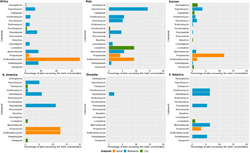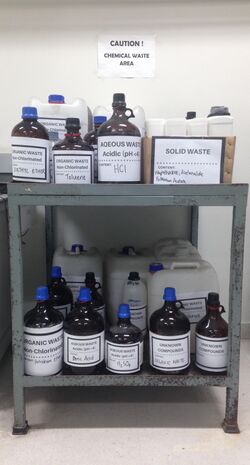Chemical waste is waste , that is made from chemicals that are mostly produced by large factories. Chemical waste can damage , the environment and cause health problems and as such may fall under regulations such as COSHH in the United Kingdom or the Clean Water Act and Resource Conservation and Recovery Act in the United States . In the U.S., the Environmental Protection Agency (EPA) and the Occupational Safety and Health Administration (OSHA), as well as state and local regulations also regulate chemical use and disposal. The disposal and handling of radioactive waste is a particular focus for regulatory bodies due to the environmental and health risks of radiation and the challenges of safe disposal. Chemical waste may or may not be classed as hazardous waste. A chemical hazardous waste is a solid, liquid, or gaseous material that displays either a "Hazardous Characteristic" or is specifically "listed" by name as hazardous waste. There are four characteristics chemical wastes may have to be considered hazardous. These are ignitability, corrosivity, reactivity, and toxicity. This type of hazardous waste must be categorized as to its identity, constituents, and hazards so that it may be safely handled and managed. Chemical waste is a broad term and encompasses many types of materials. The Material Safety Data Sheet (MSDS), Product data sheet or Label can provide a list of constituents. These sources should state whether this chemical waste is a waste that needs special disposal.
- chemical waste
- ignitability
- health problems
1. Methods of Disposal of Laboratory Chemical Wastes
In laboratories, chemical waste is usually segregated on-site into appropriate waste carboys and disposed of by a specialist contractor in order to meet safety, health, and legislative requirements.
Innocuous aqueous waste (such as solutions of sodium chloride) is sometimes poured down the sink. Some chemicals are washed down with excess water.[1] This includes concentrated and dilute acids and alkalis, harmless soluble inorganic salts (all drying agents), alcohols containing salts, hypochlorite solutions, fine (TLC grade) silica, and alumina. Aqueous waste containing toxic compounds is collected separately.
Waste elemental mercury and spent acids and bases may be collected separately for recycling.
Waste organic solvents are separated into chlorinated and non-chlorinated solvent waste. Chlorinated solvent waste is usually incinerated at high temperatures to minimize the formation of dioxins.[2][3] Non-chlorinated solvent waste can be burned for energy recovery.
In contrast to this, chemical materials on the "Red List" should never be washed down a drain. This list includes compounds with transitional metals, biocides, cyanides, mineral oils and hydrocarbons, poisonous organosilicon compounds, metal phosphides, phosphorus elements, and fluorides and nitrites.[1]
Moreover, the U.S. Environmental Protection Agency (EPA) prohibits disposing of certain materials down any drain.[4] This includes flammable liquids, liquids capable of causing damage to wastewater facilities (this can be determined by the pH), highly viscous materials capable of obstructing the wastewater system, radioactive materials, materials that have or create a strong odor, wastewater capable of significantly raising the temperature of the system, and pharmaceuticals or endocrine disruptors.
Broken glassware is usually collected in plastic-lined cardboard boxes for landfills. Due to potential contamination, they are usually not suitable for recycling. Similarly, used hypodermic needles are collected as sharps and are incinerated as medical waste.
There is research and proposals about recycling industrial waste chemicals into important drugs and agrochemicals as a potential part of a circular economy, reducing disposal costs and hazards to the environment.[5]
2. Environmental Pollution
Pharmaceuticals
PPCPs
River pollution
Textile industry
The textile industry is one of the largest polluters in the globalized world of mostly free market dominated socioeconomic systems. Chemically polluted textile wastewater degrade the quality of the soil and water.[6] The pollution comes from the type of conduct of chemical treatments used e.g. in pretreatment, dyeing, printing, and finishing operations[7] that many or most market-driven companies use despite "eco-friendly alternatives". Textile industry wastewater (TIWW) is considered to be one the largest polluters of water and soil ecosystems, causing e.g. "carcinogenic, mutagenic, genotoxic, cytotoxic and allergenic threats to living organisms".[8][9] The textile industry uses over 8000 chemicals in its supply chain,[10] also pollutes the environment with large amounts of microplastics[11] and has been identified in one review as the biggest pollution causing production sector.[12]
A campaign of big clothing brands like Nike, Adidas and Puma to voluntarily reform their manufacturing supply chains to commit to achieve zero discharges of hazardous chemicals by 2020 (global goal)[13][14] appears to have failed.
Planetary boundary
A study suggested and defines a 'planetary boundary' for novel entities such as plastic- and chemical pollution and found that it has been crossed.[15][16]
3. Chemical Compatibility Guidelines
Many chemicals may react adversely when combined. It is recommended that incompatible chemicals be stored in separate areas of the lab.[17]
Acids should be separated from alkalis, metals, cyanides, sulfides, azides, phosphides, and oxidizers, as when acids combine with these types of compounds, violent exothermic reactions can occur possibly causing flammable gas, and in some cases explosions.
Oxidizers should be separated from acids, organic materials, metals, reducing agents, and ammonia, as when oxidizers combine with these types of compounds, flammable and sometimes toxic compounds can be created.
Container compatibility
When specialists dispose of hazardous laboratory chemical waste, chemical compatibility must be considered. Safe disposal requires the container to be chemically compatible with the material it will hold. Chemicals must not react with, weaken, or dissolve the container or lid. Acids or bases should not be stored in metal. Hydrofluoric acid should not be stored in glass. Gasoline (solvents) should not be stored or transported in lightweight polyethylene containers such as milk jugs. Moreover, the Chemical Compatibility Guidelines should be considered for more detailed information.[18]
4. Laboratory Waste Containers
Packaging, labeling, and storage are the three requirements for disposing of chemical waste.
Packaging
For packaging, chemical liquid waste containers should only be filled up to 75% capacity to allow for vapor expansion and to reduce potential spills which could occur from moving overfilled containers. Container material must be compatible with the stored hazardous waste. Finally, wastes must not be packaged in containers that improperly identify other non-existing hazards.
In addition to the general packaging requirements mentioned above, incompatible materials should never be mixed in a single container. Wastes must be stored in containers compatible with the chemicals stored as mentioned in the container compatibility section. Solvent safety cans should be used to collect and temporarily store large volumes (10–20 liters) of flammable organic waste solvents. Precipitates, solids, or other non-fluid wastes should not be mixed into safety cans.[19]
Labeling
All containers should be labeled with the group name from the chemical waste category and an itemized list of the contents. All chemicals or anything contaminated with chemicals poses a significant hazard. All waste must be appropriately packaged.[20]
Storage
When storing chemical wastes, the containers must be in good condition and should remain closed unless waste is being added. Hazardous waste must be stored safely prior to removal from the laboratory and should not be allowed to accumulate.[19] The container should be sturdy and leak-proof and must be labeled.[21] All liquid waste must be stored in leak-proof containers with a screw-top or other secure lid. Snap caps, mid-sized caps, parafilm, and other loose-fitting lids are not acceptable. If necessary, transfer waste material to a container that can be securely closed. Waste containers should be kept closed except when adding waste. Secondary containment should be in place to capture spills and leaks from the primary container and segregate incompatible hazardous wastes, such as acids and bases.[22]
5. Chemical Waste in Canadian Aquaculture
Chemical waste in oceans is becoming a major issue for marine life. There have been many studies conducted to try and prove the effects of chemicals in our oceans. In Canada, many of the studies concentrated on the Atlantic provinces, where fishing and aquaculture are an important part of the economy. In New Brunswick, a study was done on the sea urchin in an attempt to identify the effects of toxic and chemical waste on life beneath the ocean, specifically the waste from salmon farms. Sea urchins were used to check the levels of metals in the environment. It is advantageous to use green sea urchins because they are widely distributed, abundant in many locations, and easily accessible. By investigating the concentrations of metals in the green sea urchins, the impacts of chemicals from salmon aquaculture activity could be assessed and detected. Samples were taken at 25-metre intervals along a transect in the direction of the main tidal flow. The study found that there was impacts to at least 75 meters based on the intestine metal concentrations.
The content is sourced from: https://handwiki.org/wiki/Chemistry:Chemical_waste
References
- null
- "Chemical Waste Management Guide | Environmental Health & Safety". https://www.bu.edu/ehs/ehs-topics/environmental/chemical-waste/chemical-waste-management-guide/.
- "Hazardous Waste Pick-Ups" (in en). 2016-11-23. https://ehs.ucla.edu/waste/services/hazardous-waste-schedule.
- "Exploring Whether Chemical Management Services are a Potential Mechanism to Facilitate the Reduction, Reuse and Recycling of Chemicals in Educational Institutions". EPA Archive document. August 29, 2022. https://archive.epa.gov/epawaste/hazard/wastemin/web/pdf/univ-report.pdf.
- Magriotis, Zuy; Saczk, Adelir; Salgado, Hélvia; Rosa, Isael (2021-07-30). "CHEMICAL WASTE MANAGEMENT IN EDUCATIONAL INSTITUTIONS". Journal of Environmental Science and Sustainable Development 4 (1): 160–176. doi:10.7454/jessd.v4i1.1064. ISSN 2655-6847. https://scholarhub.ui.ac.id/jessd/vol4/iss1/8.
- "New hazardous waste incinerator comes online". https://cen.acs.org/articles/95/i14/New-hazardous-waste-incinerator-comes.html.
- "Hazardous Waste Management Facilities and Units" (in en). 2015-07-29. https://www.epa.gov/hwpermitting/hazardous-waste-management-facilities-and-units.
- Shibamoto, T; Yasuhara, A; Katami, T (2007). "Dioxin formation from waste incineration". Reviews of Environmental Contamination and Toxicology 190: 1–41. doi:10.1007/978-0-387-36903-7_1. ISBN 978-0-387-36900-6. PMID 17432330. https://dx.doi.org/10.1007%2F978-0-387-36903-7_1
- "Waste incineration". Luxembourg: European Union. http://europa.eu/legislation_summaries/environment/waste_management/l28072_en.htm.
- pubs.usgs.gov/circ/c1196u/Circ_1196_U.pdf
- null
- "8. Management of Waste". Prudent Practices in the Laboratory: Handling and Management of Chemical Hazards: Updated Version. Washington, D.C.: National Research Council (US). 2011. ISBN 978-0-309-21158-1. https://www.ncbi.nlm.nih.gov/books/NBK55885/.
- null
- "Chemical Storage Resources" (in en). https://www.acs.org/content/acs/en/about/governance/committees/chemical-safety/publications-resources/chemical-storage.html.
- "Chemical Compatibility and Segregation Guides". National Institutes of Health (US). http://orf.od.nih.gov/EnvironmentalProtection/WasteDisposal/Pages/chem_compat.aspx.
- "How to Store and Dispose of Hazardous Chemical Waste". University of California at San Diego. http://blink.ucsd.edu/safety/research-lab/hazardous-waste/chemical.html#Select-compatible-containers.
- Pattnaik, Punyasloka; Dangayach, G. S.; Bhardwaj, Awadhesh Kumar (1 June 2018). "A review on the sustainability of textile industries wastewater with and without treatment methodologies" (in en). Reviews on Environmental Health 33 (2): 163–203. doi:10.1515/reveh-2018-0013. ISSN 2191-0308. https://dx.doi.org/10.1515%2Freveh-2018-0013
- Madhav, Sughosh; Ahamad, Arif; Singh, Pardeep; Mishra, Pradeep Kumar (March 2018). "A review of textile industry: Wet processing, environmental impacts, and effluent treatment methods" (in en). Environmental Quality Management 27 (3): 31–41. doi:10.1002/tqem.21538. https://dx.doi.org/10.1002%2Ftqem.21538
- null
- Akhtar, Muhammad Furqan; Ashraf, Muhammad; Javeed, Aqeel; Anjum, Aftab Ahmad; Sharif, Ali; Saleem, Mohammad; Mustafa, Ghulam; Ashraf, Moneeb et al. (28 February 2018). "Association of textile industry effluent with mutagenicity and its toxic health implications upon acute and sub-chronic exposure" (in en). Environmental Monitoring and Assessment 190 (3): 179. doi:10.1007/s10661-018-6569-7. ISSN 1573-2959. https://dx.doi.org/10.1007%2Fs10661-018-6569-7
- Nimkar, Ullhas (1 February 2018). "Sustainable chemistry: A solution to the textile industry in a developing world" (in en). Current Opinion in Green and Sustainable Chemistry 9: 13–17. doi:10.1016/j.cogsc.2017.11.002. ISSN 2452-2236. https://dx.doi.org/10.1016%2Fj.cogsc.2017.11.002
- Xu, Xia; Hou, Qingtong; Xue, Yingang; Jian, Yun; Wang, LiPing (20 November 2018). "Pollution characteristics and fate of microfibers in the wastewater from textile dyeing wastewater treatment plant". Water Science and Technology 78 (10): 2046–2054. doi:10.2166/wst.2018.476. ISSN 0273-1223. https://dx.doi.org/10.2166%2Fwst.2018.476



